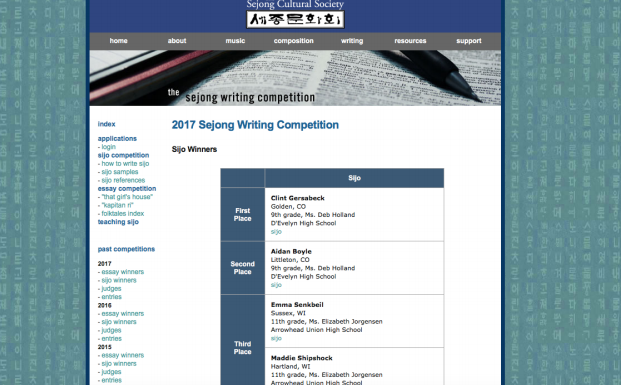Three Arrowhead Students Win National Sijo-Writing Competition
The Sejong Cultural Society, a society out of Harvard University, held it’s annual poetry writing competition. In the 2017 Sejong Writing Competition, that ended on March 6th, three Arrowhead students were awarded prizes.
The Sejong Cultural Society is a group that, according to their website, “strives to advance awareness and understanding of Korea’s cultural heritage amongst people in the United States by reaching out to the younger generations through contemporary creative and fine arts.”
Emma Senkbeil and Maddie Shipshock, both juniors at Arrowhead High School, under direction of their Creative Writing teacher, Elizabeth Jorgensen, received third place and $300.
Decker Riggan, another Arrowhead junior in Jorgensen’s Creative Writing class, received an honorable mention with the “Friend of the Pacific Rim Award” and $50.
Shipshock says, “My poem was called “Reach for the Stars” and it’s about a kid who has a large imagination. At first the poem seems like it’s about an astronaut stepping on the moon, but the twist in the third line reveals it’s really about a kid daydreaming in their backyard. When we were first introduced to the sijo, it seemed like a good challenge for me to help me think outside of the box and become a better writer. I am a very imaginative and creative person, so I was able to relate the theme of my poem to myself in a way. The sijo was one of my favorite pieces I wrote in Creative Writing so I was really excited to hear that it tied for third place!”
US and Canadian residents under age 25 were eligible to enter the competition. Other winners consisted of students from Colorado, California.
In the competition, students could either write an essay or compose a sijo, which is a traditional three-line korean poetic form typically exploring cosmological, metaphysical, or pastoral themes. Jorgensen’s students all submitted to the sijo competition.
According to the Sejong Cultural Society’s website, a sijo is “expected to be phrasal and lyrical, as they are first and foremost meant to be songs.” Although sijos are traditionally three lines, when written in English they can be six lines, each line containing two syllable groupings.
Jorgensen says she encourages her students to submit to the annual poetry competition each year in Creative Writing. “Not only do students get to learn about Korean culture and poetry, but they also learn about a new way to write. I often tell my students that sijo is haiku’s cousin. Both poetry forms focus on syllable count and are frequently written in three lines. Students tell me they like sijo because of the form and because each poem should have a twist.”
Jorgensen created video lessons for the Sejong Cultural Society. You can see her lessons and learn more about sijo here.
“I am so proud of the students who were chosen as winners. There were thousands of submissions from across the United States, so they should be very proud of themselves. Congratulations!” Jorgensen says.
Here is Senkbeil’s third place sijo:
Ex-Con
As I dash through this field of copper,
I recall cold, grey bars of steel.
Years taken but for no crime,
forgotten by those who live freely.
With a bark and a wag of my tail
I run to her, she who saved me.
Here is Shipshock’s third place sijo:
Reach for the Stars
On the moon, I plant our flag. Slow steps, through light gravity.
Surrounded by millions of stars, just me and the galaxy.
“Come inside, dinner’s ready!” Time to leave my cardboard fantasy.
Here is Riggan’s honorable mention sijo:
Our Beloved Tree
Our peach tree. I love our tree. Our immense tree. Concealed by neighbors,
where we met, where we first kissed, our sacred place, my holy spot.
I miss you… Left heartbroken, now I mourn. Beside our peach tree.
